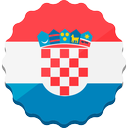General information
Croatia
Geographical position:
Croatia extends from the furthest eastern edges of the Alps in the north-west to the Pannonian lowlands and the banks of the Danube in the east; its central region is covered by the Dinara mountain range, and its southern parts extend to the coast of the Adriatic Sea.
Surface:
the mainland covers 56,542 km2, and the surface of the territorial sea is 31,067 km2.
Population:
4,437,460 inhabitants; composition of population: the majority of the population are Croats; national minorities are Serbs, Slovenes, Hungarians, Bosnians, Italians, 1 C 591 zechs and others.
Englesko hrvatski rječnikNjemačko hrvatski rječnik
System of government:
multi-party parliamentary republic.
Capital:
Zagreb (779,145 inhabitants), the economic, traffic, cultural and academic centre of the country.
Coastline:
5,835 km of which 4,058 km comprise a coastline of islands, solitary rocks and reefs. Number of islands, solitary rocks and reefs: 1,185; the largest islands are Krk and Cres; there are 50 inhabited islands.
Highest peak:
Dinara: 1,831 m above sea level.
Climate:
There are two climate zones; a temperate continental climate, locally also a mountainous climate, prevails in the interior, whereas a pleasant Mediterranean climate prevails along the Adriatic coast, with an overwhelming number of sunny days, dry and hot summers, mild and humid winters; average temperature in the inland: January 0 to 2°C, August 19 to 23°C; average temperature at the seaside: January 6 to 11°C, August 21 to 27 °C; the temperature is about 12°C in winter, and 25°C in summer.
Currency:
kuna (1 kuna = 100 lipa). Foreign currency can be exchanged in banks, exchange offices, post offices, travel agencies, hotels, camps, marinas; cheques can be cashed in banks.
Adriatic Sea
The Adriatic sea got its name from an ancient port of the same name. The Adriatic spans from the Balkan to the Apennine peninsula.
The part belonging to the Republic of Croatia is the eastcoast which extends all the way from Prevlaka in the south to cape Savudrija in the west,including all islands, islets and cliffs along the coast,and the archipelago of Palagruza (the number of islands, islets and cliffs is more than 1700).
This is a unique area in Europe forcruising with motor boats, speedboats, or sailboats, but also for enjoying the underwater world.
Islands
Croatia is truly a land of islands because it has more than a thousand of them and each one is different. Many of them are inhabited but each and every one is exceptional, with its own story and destiny. To have a weak spot is human and the connoisseurs of Croatian islands have thousands of them. To be more precise 1185 of them.
That's how many islands, islets and cliffs are located in front of 1777 kilometers of the Adriatic coast. The first trip to the Adriatic coast and its islands is a journey into the unknown.
Every other trip will be a journey to the already familiar beauty of this country, always different but equally breathtaking.





